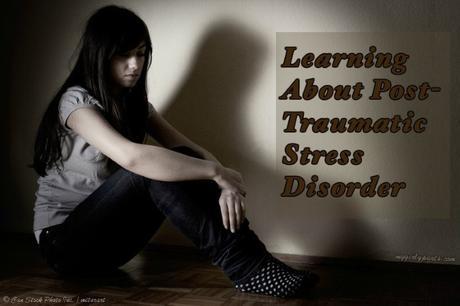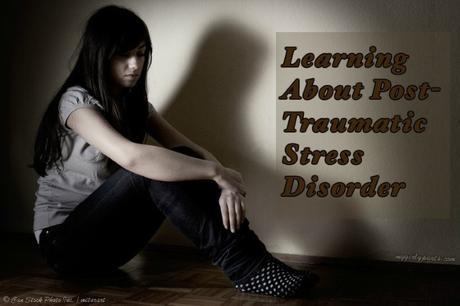


My husband recently went through a very traumatic experience at work. He witnessed an extremely violent scene and was very affected by it. So much so that he is now off work to recuperate and to deal with what he saw.
So since June is post-traumatic stress disorder awareness month and June 27 is PTSD awareness day, I thought this was the most appropriate time to talk about PTSD.
What is PTSD?
Once only associated with military officers, post-traumatic stress disorder affects 2.2% of the population and 11-20% of veterans of the Iraq and Afghanistan wars. It is now recognized by the Diagnostic and Statistical Manual of Mental Disorders (DSM-5) as an anxiety disorder brought on by a traumatic event.
Here is a definition, according to the Mayo Clinic:
“Post-traumatic stress disorder (PTSD) is a mental health condition that’s triggered by a terrifying event — either experiencing it or witnessing it.”
What can cause PTSD and who is at risk?

Like we just saw in the definition, post-traumatic stress disorder can be caused by witnessing a traumatic event. But what are those events exactly? Usually, PTSD is triggered by observing a violent event like:
- Being assaulted or attacked by someone
- Being in a severe accident
- Experiencing a natural disaster
- A terrorist attack
- Combat
- The death of a loved one
- Childhood abuse or neglect
Although it can occur at any age, even as a small child, not everybody is at risk of developing PTSD. Only certain types of people are more susceptible to be affected by this condition. Furthermore, 10% of women will develop PTSD for 5% of men during their lifetime.
Having a history of mental illness or family history of mental illness, having a job with higher risk of being exposed to traumatic events such as military personnel or paramedics, or lacking a support system are some of the factors that can make you at risk of developing PTSD.
What are the main symptoms of PTSD
Post-traumatic stress disorder, also known as shell shock, can cause a multiple of symptoms. But the main ones are:
- Avoiding things or events related to the traumatic experience
- Flashbacks or unwanted memories
- Disturbed sleep with nightmares about the event
- Irritability with violent outburst
- Difficulty concentrating
- Anxiety or depression
- Feeling tense or “on edge” (hyperarousal)
People suffering from PTSD can also isolate themselves in the hope of avoiding events that can trigger flashbacks or anxiety. They can have feelings of detachment from family and friends causing them to isolate themselves even more.
How is PTSD diagnosed?
To be diagnosed with PTSD, the person must experience the symptoms within three months of the event and have the symptoms for at least one month. Moreover, the doctor will conduct a physical and a psychological evaluation.
The doctors will have to follow criteria from the DSM-5 published by the American Psychiatric Association. To get a diagnose of PTSD, a person must have all three of the following criteria:
- One or more re-experiencing symptoms
- Three or more avoidance symptoms
- Two or more hyperarousal symptoms
Daily life activities and tasks must be difficult to do like going to school or work, paying bills, visit friends, etc.
What are the treatments available for PTSD
Many treatments are available to help people with PTSD. Although several of these people don’t seek help, those treatments are proven to be successful with the symptoms. I found this video below, created by the National Center for PTSD, where you’ll learn everything about the treatments available.
The Posttraumatic Stress Disorder (PTSD) infographic
Military Pathways has designed this infographic below where you will find all you need to learn about post-traumatic stress disorder. This infographic is full of interesting facts and is really easy to understand. I have looked at many infographics on the subject, and I can tell you that this one is the most exhaustive.

An infographic by the team at Military Pathways
Learning About Post-Traumatic Stress Disorder #Infographic #Video #MyGirlyPartsMy husband’s situation explained
It’s only been one month since my husband witnessed the horrible scene that affected him profoundly. At this point, we still don’t know if he’ll recover from it or if he will be able to go back to work. To sum it all up, we don’t know if he will suffer from PTSD.
One thing I can tell you is that my husband receives the best care possible. He is followed by a doctor and a psychologist, and he has medication to help him sleep and deal.
He has friends and family who take care of him and try to make his recovery as comfortable as possible. So, we hope for the best, but only time will tell if he will suffer from PTSD.
Over to you
Do you know someone who has been affected by PTSD? Did you know that people other than military veterans could develop this condition? Please, share with us in the comment box below. I would love to hear your thoughts on the subject.
Embed This Infographic On Your Site (copy code below):
<img src=http://thumbnails-visually.netdna-ssl.com/military-ptsd–post-traumatic-stress-disorder_50291197cef38_w1000.jpg width=540> <p>Post Traumatic Stress Disorder (PTSD) – An infographic by the team at <a href=http://afterdeployment.dcoe.mil/military_pathways>Military Pathways</a>
072100Share on Pinterest

 More share buttons0Share with your friendsYour Name
More share buttons0Share with your friendsYour NameYour Email
Recipient Email
Enter a Message
I read this article and found it very interesting, thought it might be something for you. The article is called Learning About Post-Traumatic Stress Disorder #INFOGRAPHIC #VIDEO and is located at http://www.mygirlyparts.com/2015/06/post-traumatic-stress-disorder/.
Captcha
Submit

